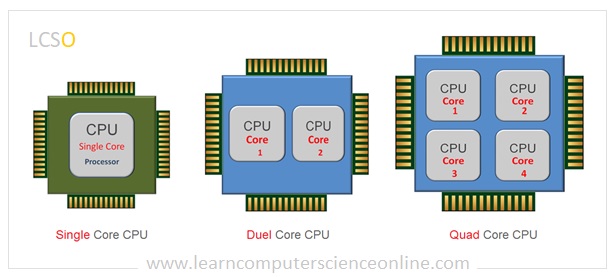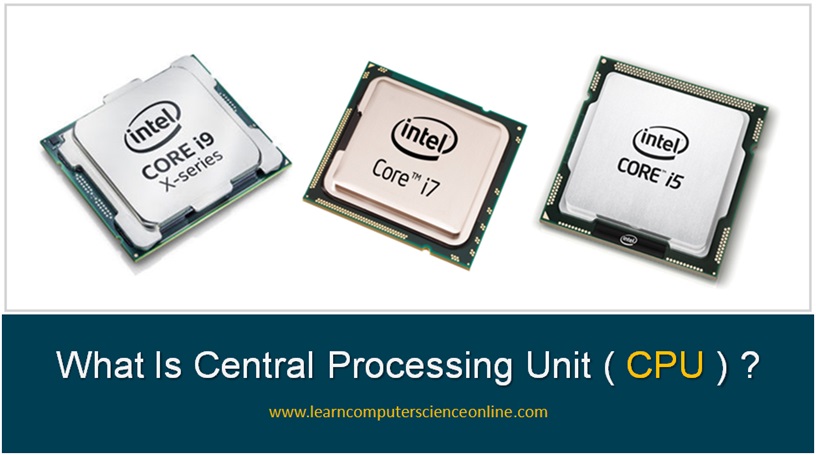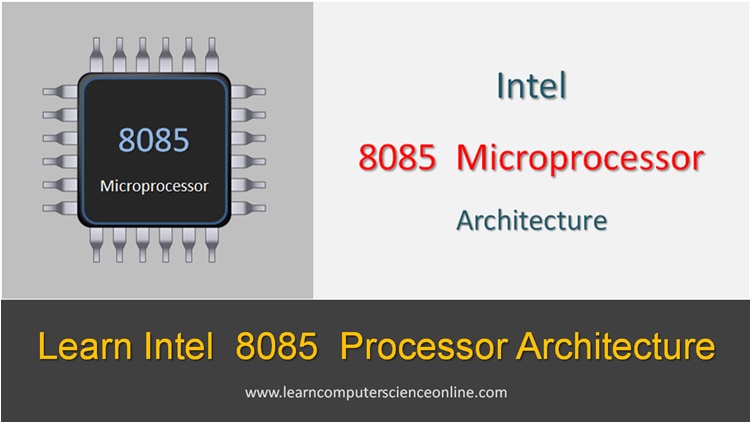
What Is CPU ?
How CPU Works | CPU Functions | Definition
Microprocessor | Central Processing Unit | Processor Types
The CPU stands for, Central Processing Unit. It is also referred to as Microprocessor , Processor and functions as a brain of the computer system.
The CPU is one the most important component of computer that works as processing engine and the workhorse of the computer system.
It is the central processing unit that takes the logical decisions and performs all arithmetic calculations necessary to execute the program on the computer system.

It is the microprocessor that actually provides the processing power to the computer system. The processor works at very high speed and performs millions of calculations per second in order to execute the program.
The processor is installed on the main printed circuit board PCB called motherboard. The processor is protected from damage due to heat by the colling fan placed on the top of the processor.
In this article , you will learn , what is CPU ? , How processor works ? , Functions and features of the microprocessor, processor types ( single and multi-core processor ) and other important topics related to the central processing unit.
What Is CPU ?
What Is Central Processing Unit ?
The computer systems are extensively used for various applications primarily due to its ability to process large volumes of data at very high speed. It is the CPU which provides the high speed processing capability to the computer system.
The CPU is an electronic component that is packed with integrated circuit ( IC ) chips. The CPU controls all the operations performed by the computer system. The CPU is also responsible to execute the computer program.
The C P U provides the processing power to the computer system . The computer hardware technology is growing at fast pace and new processors are being introduced in the market with significant improvement in the processing power.
The famous Moors law had predicted this rapid advancement in the computer hardware technology long back especially in the processing power of the CPU. As per this law , the CPU processing power will double every two years.
The commercial name of the CPU is “Microprocessor” or simply a processor. The CPU is said to be the brain of the computer system. The CPU performs all the arithmetic calculations and logical operations to perform various operations.
CPU Features
What Are The Featuress Of CPU ?
The microprocessor works as a brain of the computer system. The CPU is the most important component of the computer system and its important features include :
- The processor has three functional units ALU , CU and MU.
- CPU has Cache memory ( L1 ).
- The L1 cache memory is CPU’s internal memory.
- The processor also contains highspeed memory called registers.
- The processor can be either single core or multi-core processor.
- Processor speed is the clock speed measured GHz (Gigahertz).
- Latest modern processor supports multi-threading.
- The CPU needs compatible motherboard and RAM.
- The CPU bandwidth is number of data transfer paths.
- The processor needs a heatsink to cool down.
CPU Architecture
What Are Main Parts Of CPU ?
In order to understand the CPU architecture and the functions of the internal components of the processor , we need to first discuss , how a processor executes the program.
The Operating System ( OS ) loads the program to be executed into the main memory RAM. The CPU starts the program execution by fetching the data and program statements from the main memory into the processor memory unit.
The C P U operates on the data as per the program instructions and stores the processed data back into the main memory RAM . The operating system sends this data to the output device such as monitor.

CPU Architecture
What Are Main Components Of CPU ?
The Central Processing Unit ( CPU ) is internally consist of three major units. In other words , the microprocessor processing functions can be grouped into three functional units. These three functional units include :
- Arithmetic Logic Unit ( ALU ) .
- Control Unit ( CU ).
- Memory Unit .
Arithmetic Logic Unit ( ALU )
The Arithmetic Logic Unit ( ALU ) of the CPU performs all the arithmetic and logical operations. The ALU performs the desired operation on the data as specified in the program code.
The control unit ( CU ) first decodes the program instructions and directs the ALU to operate on the data. The ALU then performs the desired operation on the data as per the OP Code ( Operation Code ) decoded by the CU.
What Is CPU ?

How CPU Works ?

Control Unit ( CU )
The control Unit ( CU ) Of the processor controls the functioning of all the internal components and other devices connected to the system.
The control unit also decodes the each program instruction as per the OPCODE and ALU then performs the operation on the OPERAND.
Machine Instruction.

Machine Instruction Format.

CPU Memory Unit
The processor works at very high speed and makes use of high speed internal memory called CPU registers.
The memory unit in a processor consist of high speed memory that is used by the processor to store the data during the program execution.
CPU And Motherboard Architecture
The motherboard is the main printed circuit board ( PCB ) in a computer system where all the major system components are interconnected.
The microprocessor chip is placed on the motherboard into the processor socket which firmly holds the processor chip .
The processor socket on the motherboard comes with a liver locking mechanism where the processor chip is installed.

The CPU works at very high speed that generates considerable heat. And therefore, a heat-sink with small cooling fan is mounted on the top of the processor chip which protects the processor chip from damage due to excessive heat.
How CPU Executes Program ?
Machine Cycle
Instruction Cycle
The main function of the CPU is to execute the program. The operating system allocates the necessary resources in terms of main memory RAM and the processor time in order to execute the program.
The program code contains number of program statements. Each program statement is an instruction to the CPU to perform a specific task. The processor has to repetitively perform the Instruction Cycle which is the basic operation of the CPU.

The machine cycle consist of, four basic operations performed by the CPU. These four instruction cycle operations include :
What Are CPU Cores ?
Single-Core Processor
Multi-Core Processor
The CPU internally consists of three functional unites which include Arithmetic and logic unit ALU, control unit CU and memory unit MU. These three units together is referred as core of the processor.
A modern latest generation processor consists of either one or multiple cores depending upon the CPU architecture. The single core processor can process only one instruction at a time. Whereas, the multi-core processor can process multiple instructions simultaneously.

When the processor contains only one core it is referred as single core processor. A processor can also contain more than one core for additional processing power and processor with multiple cores is called multi-core processor.
CPU Instruction Cycle Steps
- 1. FETCH
- 2. DECODE
- 3. EXECUTE
- 4. STORE
What Is Instruction Cycle ?
The instruction cycle is the main activity performed by the central processing unit ( CPU ) to execute the program instruction. The Machine cycle is also alternately referred to as Instruction cycle but it is a part of the instruction cycle.
The instruction cycle is the main operation performed by the processor and it is also called as processor cycle. Whereas, the instruction cycle is the process initiated by the CPU to execute one program instruction .
CPU Instruction Cycle
Difference Between Instruction Cycle And Machine Cycle
The instruction cycle is the process used by the processor to execute one instruction. The machine cycle is just a one step of the instruction cycle.
Depending upon the complexity of the program instruction, the processor might need one or more machine cycles to execute one instruction.
The processor takes minimum one and maximum four machine cycle to execute one program instruction. Whereas, one machine cycle takes twelve clock cycles.

CPU Functions
What Are The Functions Of CPU ?
The CPU performs some of the most important functions in a computer System and these functions include :
- To Perform Arithmetic Calculation Operations.
- To Perform Logical Operations.
- To Control Functions Of Other Hardware Components.
- To Fetch the Data And Program Instructions From Main Memory.
- To Decode the Program Instructions.
- To Operate On Data As per Program Instructions.
- To Store Data After Processing.
- To Continuously Execute Instruction Cycle / Machine Cycle.
Join The Best Seller
Computer Science Online Course
This is the most comprehensive and unique Computer Science And Programming Fundamentals course Online which will give you in depth understanding of most important fundamental concepts in computer science And Programming .
Sharing is caring!



